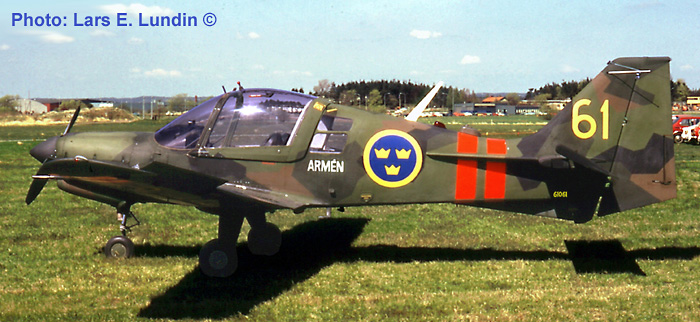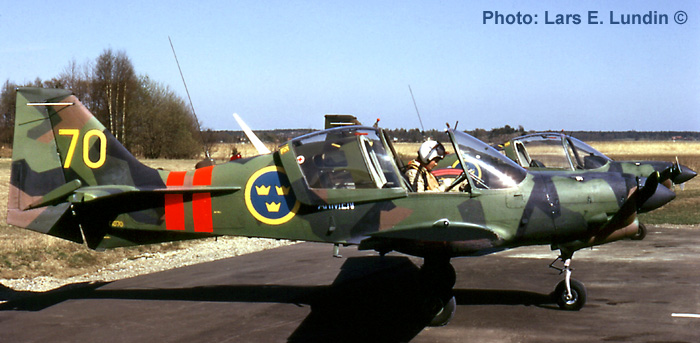|
|
||
| FPL 61C BAe/Scottish Aviation Bulldog (1972-1998) | ||
|
|
Page 1(3) |
|
|
|
||
 |
||
|
This page: Basic information
The
Bulldog design was a based on the well-known Beagle Pup. The side doors
were deleted and instead a sliding canopy was used. The aircraft was three-seated
with the seats for teacher and student placed side-by-side.
The
delivery of the 58 aircraft
to the Air Force took place in 1971-1972. They were given military
registration numbers 61001 - 61058. The Swedish designation of the type
became SK 61, with the sub
designations SK 61A for the
standard unarmed variant and SK
61B for six aircraft that could carry the RB 53
wire-controlled Bantam missile. The missile casing was fitted at the
starboard wing tip and the missile was controlled from the starboard
seat. The installation of the RB 53 at some of the Bulldogs was
sometimes utilized to train AJ 37 Viggen pilots before using the
advanced (and much more expensive) RB 05 attack missile. The latter was
like the RB 53 controlled by the pilot, although with radio signals.
In
1972-1973, the Army got its 20 Bulldogs. These aircraft were designated FPL 61C and got registration
numbers in the interval 61061-61080. This version
was mainly intended for liaison and for artillery fire spotting and
direction. For this duties it had additional equipment as wire cutter
and radio equipment for communication with army units on the ground. The
rear windows could be opened for photographing from the air. Skis were
delivered to the aircraft that were based in the North of Sweden. As the
Bulldog is nose-wheeled, it took several years to solve this problem
satisfactory. The nose-wheel and the smaller main wheels required better
airstrips than the earlier tail-wheel designs (like the Super Cub).
As the SK 61 was intended as a combat aircraft, none of them was painted in the usual trainer yellow colour. The Air Force Bulldogs were initially painted in a dark olive green/dark blue camouflage scheme at the top and in blue-grey at the bottom surfaces.
The Army
aircraft were painted in the more ambitious four-colour camouflage
scheme developed primarily for the AJ 37 Viggen.
In
the beginning, the SK 61 was used for basic training at the
Some
SK 61s were equipped with avionics for training of civilian commercial
pilots at TFHS (Trafikflyghögskolan – Lund University School of
Aviation), also located at Ljungbyhed. These aircraft are designated SK
61D and SK 61E, depending
on the equipment installed. F 5 was disbanded in 1997. A few years
later, TFHS had to transfer its Bulldogs to the civil register. 28
aircraft were modified to civil regulations 2000-2001.
Many of the
ex. SK 61:s have
been
sold abroad.
The
FPL
61C
was powered by a Lycoming IO-360-A1B6 engine, delivering 200
hp.
Photo
above: FPL
61C # 61061 (c/n 179) at Norrköping, 1974-05-11. More photos at Trainer Aircraft - SK 61.
FPL
61C: Length: 7,08
m. Span: 10,11
m.
Height: 2,73 m.
MTOW: 1.065 kg. Max. speed: 261 km/h. |
||
|
For the Model Builder Revell has since many years ago a model Scottish Aviation Bulldog in their assortment. Scale 1:72. All versions can be built from the box except SK 61B which needs homemade boxes under the wings for the Bantam missile. Kit number 01061.
The kit below is probably
hard find today. It contains decals of the Swedish SK 61 # 61033 with the
crest of the War Flying School (F 5) in Ljungbyhed painted
on the fin.
RAF decals are also included. Kit number 0061. |
 |
|
 |
||
 |
||
|
|
||
|
|
||
|
|
||
|
© Lars Henriksson |
|
Updated 2010-08-30 |
|
Custom Search
|
||